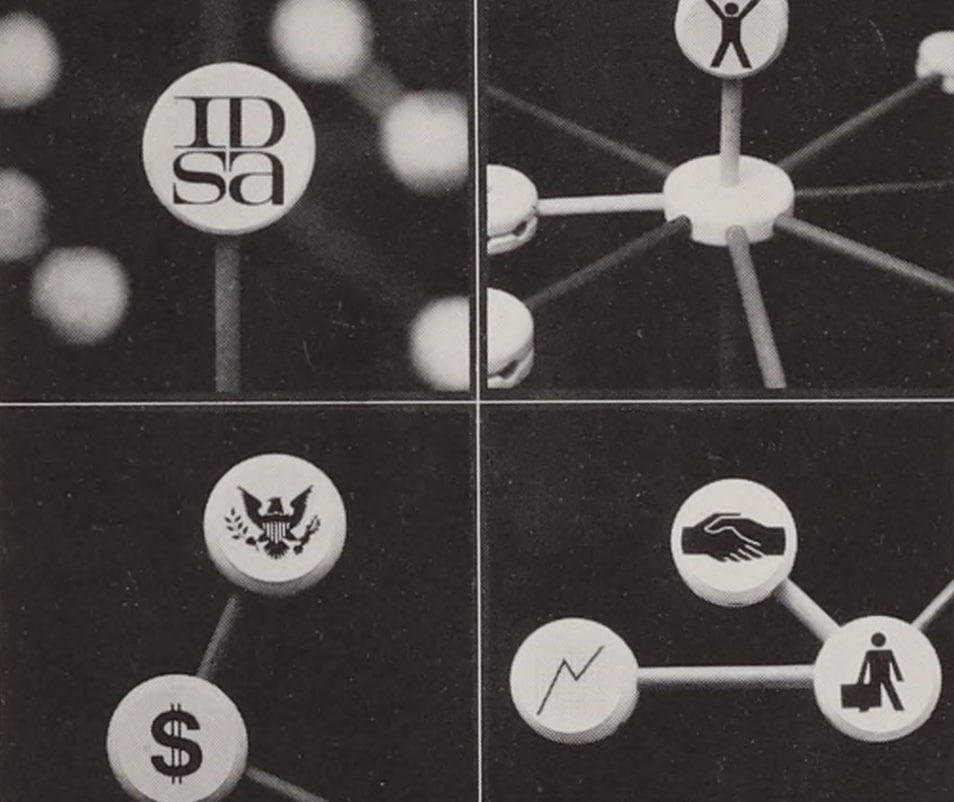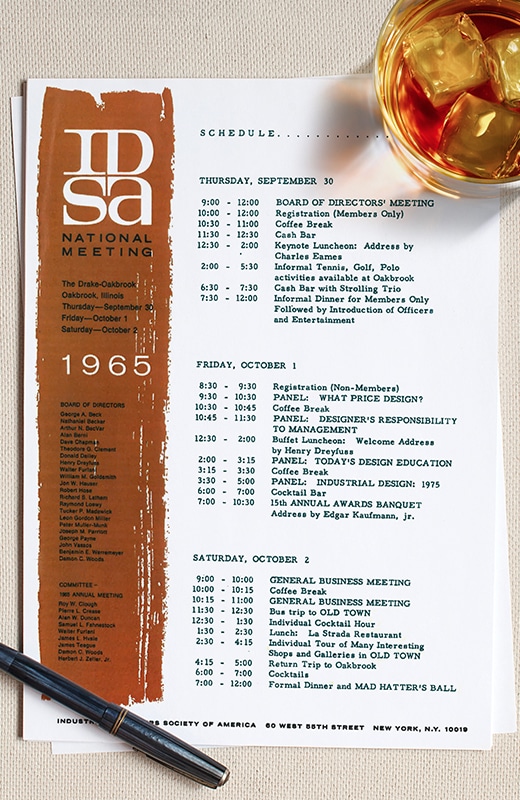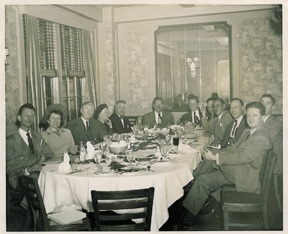Our Story
Founded in 1965, the Industrial Designers Society of America is one of the oldest and largest industrial design associations in existence.

The founding of IDSA
The Industrial Designers Society of America (IDSA) was formed in 1965 after over 10 years of careful negotiations by the collaborative merger of several existing design organizations, the Industrial Designers Institute (IDI), the American Society of Industrial Design (ASID), and the Industrial Design Education Association (IDEA). In doing so, the strengths, purposes and varied philosophies of its predecessors combined to become the single voice of industrial design in the U.S.
At the time of its founding, it consisted of about 600 members in 10 chapters across the country. The first Chairman of its Board was John Vassos (1898-1985), the founder of ADI, and its first President was Henry Dreyfuss (1904-1972). The organization’s original headquarters was located in New York City, New York.
The first national meeting of IDSA took place on September 30 – October 2, 1965 in Oakbrook, Illinois, a suburb of Chicago. The event covered subjects such as “Designer’s Responsibility to Management,” “Today’s Design Education,” as well as a panel discussion on “Industrial Design 1975.” Famed designer Charles Eames delivered the keynote address.
In the first issue of the Journal of the Industrial Designers Society of America (September 1968), then IDSA President Robert H. Hose, FIDSA wrote about the importance of IDSA’s membership Code of Ethics, “As Industrial Designers we have a responsibility to our clients, to our community, to the public and to our profession. This responsibility requires that we all be men and women of integrity, with business capacity, as well as artistic and technical proficiency. Our work endures as a favorable or unfavorable reflection on our Society and the profession at large.” These are values we still hold today.
By 1980, IDSA had re-initiated its annual national design awards and revised its bylaws significantly. Around that same time, the headquarter office was relocated to the Washington, DC area where it remains today, though with an increasingly distributed staff. IDSA founded The Design Foundation – a 501c(3) organization – in 2001 as a means to expand the Society’s outreach and educational efforts. Further updates to the organizational bylaws were implemented by the Board of Directors in 2017 to update its operations for a new generation.
Today, IDSA maintains a roster of around active 2,500 members in the United States and internationally, and produces a wide range of annual programming for a broad community of design professionals. Our Professional Chapters are quite active and are led by 100% volunteer teams who are supported with tools and resources from the IDSA headquarter staff. These communities help to foster professional development through the delivery of localized programming and networking opportunities.
IDSA continues to advocate for the profession of industrial design and is an active member of the World Design Organization.

Industrial design organizations before IDSA
Original words by the late Carroll M. Gantz, FIDSA, president of IDSA from 1979-80. Edited for clarity and revised to update content.
The organization of professional designers can be traced to the beginning of the profession itself, which first came to the attention of the general U.S. public in 1927. That year, Macy’s in New York held a well-attended Exposition of Art in Trade. This featured “modern products,” many of them from the 1925 International Exposition of Modern Decorative and Industrial Arts in Paris, which was belatedly recognized by the U.S. government as an important “modern movement.”
Immediate public and manufacturer demand for these new “Art Deco” styles was so obvious, and the need so great, that a number of design professionals (often architects, package designers or stage designers) focused their creative efforts for the first time on mass-produced products. They claimed the new title of “industrial designer” which had originated in the U.S. Patent Office in 1913 as a synonym for the then-current term “art in industry.”
American Union of Decorative Artists and Craftsmen (AUDAC)
AUDAC was founded to protect its members industrial, decorative and applied arts concepts from piracy, and to exhibit their new work. AUDAC attracted a broad range of artists, designers, architects, commercial organizations, industrial firms and manufacturers. Within a few years, it had more than a hundred members, and held major exhibitions in 1930 and 1931.
The National Furniture Designers' Council (NFDC)
Founded in 1933, NFDC brought together a number of furniture representatives and designers to draw up a code for the National Recovery Administration (NRA) to prevent design piracy. But in 1934, NRA was declared unconstitutional and NFDC disbanded.
American Designers Institute (ADI)
In 1936, the American Furniture Mart in Chicago invited leading designers to form a new organization called the Designers’ Institute of the American Furniture Mart. Some members felt restricted by the sole patronage and sponsorship of the furniture industry, and in 1938 they founded a broader-based organization called the American Designers Institute (ADI), which allowed specialization in one of many design areas, including crafts, decorative arts, graphics, products, packaging, exhibit or automotive styling, to name a few. ADI’s first president was John Vassos (1898-1985).
Society of Industrial Designers (SID)
In February 1944, fifteen prominent East Coast design practitioners established the Society of Industrial Designers (SID). Each of the founding members invited one additional designer to join the following year. Membership requirements were stringent, requiring the design of at least three mass-produced products in different industries. SID was formed in part to reinforce the legality of industrial design as a profession, and to restrict membership to experienced professionals. SID’s first president was Walter Dorwin Teague.
Industrial Designers Institute (IDI)
In 1951, ADI relocated its administrative center to New York, absorbing the Chicago Society of Industrial Designers (CSID) in the process and changing its name to the Industrial Designers Institute (IDI). That year, IDI initiated annual national design awards, which continued through 1965. By 1962, IDI had about 350 members in 10 city chapters across the country. Image: 1950 gathering of the Board of Directors of ADI with Bob Goldberg as president.
 Around the table, I to r, are: Paul Wrablica, Belle Kogan, Ben Nash, Ann Frank, John Vassos, Frank Gianninoto, Bob Goldberg, Bob Gruen, Clarence Hornung, Dan Grant
Around the table, I to r, are: Paul Wrablica, Belle Kogan, Ben Nash, Ann Frank, John Vassos, Frank Gianninoto, Bob Goldberg, Bob Gruen, Clarence Hornung, Dan Grant
American Society of Industrial Design (ASID)
In 1955, The Society of Industrial Designers (SID) changed its name to the American Society of Industrial Design (ASID). The ASID was a small, elite group of primarily consultant designers (because of their requirement that a candidate show work in three different product categories), so their membership was under 200 people and Ellen Manderfield was the first woman to be allowed entry in 1957. By 1962, ASID had about 100 members in four chapters nationally.
Industrial Design Education Association (IDEA)
In 1957, The Industrial Design Education Association (IDEA) was founded because neither professional society (IDI or ASID) accepted educators as full members. Its first president was Joseph Carriero (1920-1978).